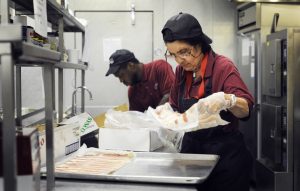 As you may already know, there’s a Baltimore city government program called “Vacants-To-Value.” It’s primary purpose is to encourage people to refurbish and move into vacant property around the city – properties, mostly residential, that the government has taken over. The objective is to turn the huge number of abandoned properties around the city into homes that are attractive and well-maintained by resident-owners, many of whom will be new to the neighborhood.
As you may already know, there’s a Baltimore city government program called “Vacants-To-Value.” It’s primary purpose is to encourage people to refurbish and move into vacant property around the city – properties, mostly residential, that the government has taken over. The objective is to turn the huge number of abandoned properties around the city into homes that are attractive and well-maintained by resident-owners, many of whom will be new to the neighborhood.
On the face of it, the program makes sense. Over the past 60 years, the city has lost over 300,000 people, all of whom used to live somewhere. Their departure left behind a very large number of vacant properties. Of the 620,000 people still here, a quarter live below the poverty level, at least 25,000 are unemployed and who knows how many are working, but unable to make a living wage. Many of these families are renters who lack the resources to own their own homes. Unfortunately, some of their landlords are unable or unwilling to maintain their rental properties. Of the lower-income families that are homeowners, many of them just can’t afford to maintain their homes as well as they would like, if only they made more money.
Except for the downtown/harbor area and a few selected communities here and there, the city’s economy is a mess. There are two cities really. One that works and makes a decent living. The other that’s struggling every day to get by.
At present, there are over 34,000 vacant properties – buildings and vacant lots – that have been cataloged by the city and more that haven’t. Of these 34,000, the city owns less than 5000. Everything else is stuck in the hands of private owners and is not readily available as a tool for encouraging economic recovery.
Against these huge numbers, the Vacants-To-Value program has had no material effect. It’s a good idea, a nice program that isn’t the right program for its time, for a city in this much trouble. The disadvantaged communities in Baltimore don’t need a relative handful of houses refurbished. They need jobs. Jobs first for the people who already live in these neighborhoods and then, later, more people to move into vacant homes, in that order.
 And so, Baltimore Rising is working to introduce legislation for what we’re calling the “Vacants-To-Jobs” program. To be clear, V2J is a work in progress, prospective legislation that, with the help of one exceptional member of the City Council in particular and others in the city government, we hope to get in front of the City Council in January. We’ll get it done. Until then, when the legislation is passed, here’s how the program will work…
And so, Baltimore Rising is working to introduce legislation for what we’re calling the “Vacants-To-Jobs” program. To be clear, V2J is a work in progress, prospective legislation that, with the help of one exceptional member of the City Council in particular and others in the city government, we hope to get in front of the City Council in January. We’ll get it done. Until then, when the legislation is passed, here’s how the program will work…
- First and foremost, this program is specifically and exclusively for those neighborhoods in the city where employment levels and rates are excessive.
- From the already substantial inventory of city-owned vacant properties located in neighborhoods were unemployment is excessive, established employers of relatively low skilled, on-the-job trained labor who are willing to expand in these disadvantaged communities will be given free land on which the employers can build what they need from scratch or free property with buildings that the employers can refurbish.
Employers are free to choose whatever properties they want. Properties will then be awarded, based on applications the city receives, on a monthly basis with preference being given to employers creating the highest number of jobs per acre but, honestly, there’s plenty of vacant property to go around.
We’re talking about employers of whatever size, of virtually any description – commercial, industrial, whatever – from within the city, metropolitan area, mid-Atlantic region or around the country. Notice that we said “established.” The program is not about startups. Small businesses are okay, larger ones too, just not brand new ones. The problem with startups is that most of them fail within their first 3 years in business. We want established businesses that a neighborhood can count on to provide jobs and keep people working.
- While there are over 34,000 tagged vacant properties in the city, the city owns fewer than 5000 of them. Is st’ll a large number and those are the properties to which the free land portion of the program will apply. A list of these properties is available at the city’s Vacants-To-Value website.
If you’re an employer and you’re interested in one or more vacant properties the city doesn’t already own, you should contact the owners and see what the properties will cost you. Otherwise, you can talk to the city, and you should, but it takes months, often well more than a year before privately-owned property can be taken over by the city.Whether or not the vacant properties are city-owned, the property tax savings portion of V2J will still be available to employers – provided the taxes on these properties are delinquent, are not being paid. The point is, V2J saves you property taxes, but not at the city’s expense. Right now, the city needs all the revenues it can collect. V2J is about growing the city’s tax base through the beneficial effects of jobs creation, not reducing it.
- In addition to the free property, no property taxes for 5 years. More specifically, employers will not have to pay the city’s portion of the property taxes – which is most of what everyone else pays. A small portion of the property tax goes to the state and can’t be excused by the city. Employers who develop vacant properties not-owned by the city, but that located in the program’s target, high unemployment neighborhoods will also enjoy this tax savings even though they will not be receiving free property.
- In addition, the city will provide greatly expedited rezoning and permitting for construction and occupancy. When you’re a city in trouble – and Baltimore is certainly that – planning and zoning can’t be proactive. There’s no way even the most astute planners can anticipate the thinking of the employers who are interested in this program. No way.
 For the program to work, planning and zoning need to be reactive. This is an emergency. The city, including the Baltimore Development Corporation, needs to stop thinking in terms of high tech, high skilled business and downtown and harbor development and do whatever it takes, quickly, in a few weeks, not months, to get employers into those sections of the city where unemployment, under-employment and poverty are high.
For the program to work, planning and zoning need to be reactive. This is an emergency. The city, including the Baltimore Development Corporation, needs to stop thinking in terms of high tech, high skilled business and downtown and harbor development and do whatever it takes, quickly, in a few weeks, not months, to get employers into those sections of the city where unemployment, under-employment and poverty are high.
Simply put, in just 5 bullets, that’s what we’re proposing. There are many details, of course, such as that the program will be aggressively advertised around the country, but these 5 bullets are the gist of it.
If these employers need financing, Baltimore Rising will help them get it.
So why are we telling you this? Because, if you’re an employer who is expanding or  considering relocating, we want you to know that Vacants-To-Jobs is coming. And if you’re a citizen in need of work or just someone who cares about your city, we’re asking for your support so that your Councilman or woman will vote for the program. The encouragement of candidates for Mayor and City Council is also welcome.
considering relocating, we want you to know that Vacants-To-Jobs is coming. And if you’re a citizen in need of work or just someone who cares about your city, we’re asking for your support so that your Councilman or woman will vote for the program. The encouragement of candidates for Mayor and City Council is also welcome.
As always, your comments and suggestions will be greatly appreciated, but here’s the deal…
- Don’t tell us how hard it will be to get this done. We know how difficult it is to change the way a bureaucracy thinks. We fully appreciate that the sense of urgency we feel on behalf of the city’s families who are struggling – and have been for decades and generations – may be difficult to communicate to our city government and build into its programs. But then we have no choice, do we? So, with your help, we’re going do this. Because we can save a great American city and because, if we don’t turn the economy of Baltimore around, now, the consequences of that failure are unacceptable.
- Don’t tell us about this or that problem or shortcoming in the program’s design without, at the same time, making a suggestion as to how we can overcome or correct it.
Thank you for letting us know what you’re thinking.


